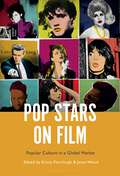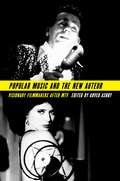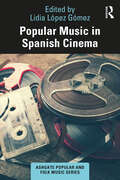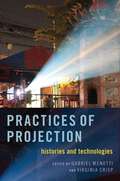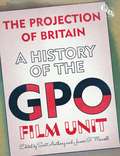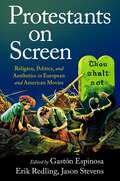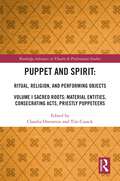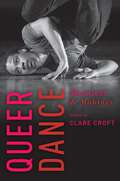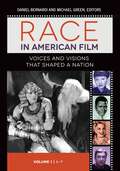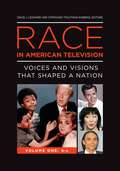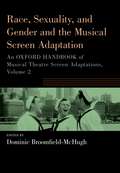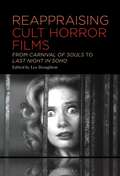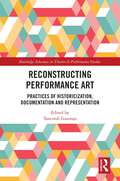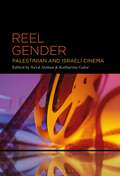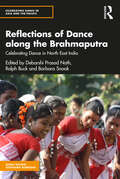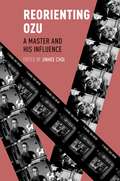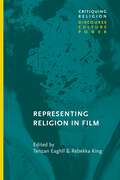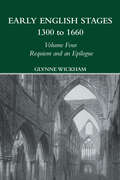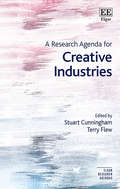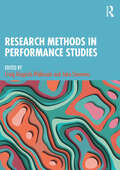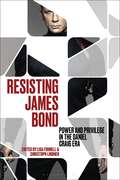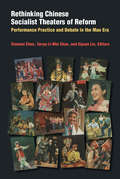- Table View
- List View
Pop Stars on Film: Popular Culture in a Global Market
Pop stars have provided audiences with performative moments that have become ingrained in popular consciousness. They are a lens through which deeper understandings about race, gender, politics, history and the artistic process can be understood. When combined with the most affective of mediums – cinema, the combination can be both thrilling and alarming.From the relatively early days of cinema, figures from the world of popular music have made forays into acting and contributed cameo appearances. From Little Richard and Kylie Minogue to Nick Cave and Tom Waits, Pop Stars On Film: Popular Culture in a Global Market offers a collection of essays on some of the most influential international performances from a diverse range of cultural icons. The book considers industry shifts, access and diversity, but also the notion of cultural appropriation, audience appeal, marketing and demographics. Perhaps most importantly, the publication will look at what happens when cultures collide and coalesce.
Popular Music and the New Auteur: Visionary Filmmakers after MTV
MTV utterly changed the movies. Since music television arrived some 30 years ago, music videos have introduced filmmakers to a new creative vocabulary: speeds of events changed, and performance and mood came to dominate over traditional narrative storytelling. Popular Music and the New Auteur charts the impact of music videos on seven visionary directors: Martin Scorsese, Sofia Coppola, David Lynch, Wong Kar-Wai, the Coen brothers, Quentin Tarantino, and Wes Anderson. These filmmakers demonstrate a fresh kind of cinematic musicality by writing against pop songs rather than against script, and allowing popular music a determining role in narrative, imagery, and style. Featuring important new theoretical work by some of the most provocative writers in the area today, Popular Music and the New Auteur will be required reading for all who study film music and sound. It will be particularly relevant for readers in popular music studies, and its intervention in the ongoing debate on auteurism will make it necessary reading in film studies.
Popular Music in Spanish Cinema (Ashgate Popular and Folk Music Series)
Popular Music in Spanish Cinema analyses the aesthetics and stylistic development of soundtracks from national productions, considering how political instability and cultural diversity in Spain determined the ways of making art and managing culture. As a pioneering study in this field, the chronologically structured approach of this book provides readers with a complete overview of Spanish music and connects it to the complex historical events that conditioned Spanish culture throughout the 20th century to the present day, from the Second Republic, the Spanish Civil war, and the dictatorship through to democracy. The book enables an understanding of the relationships between the recording and film production industries, the construction of collective imagination, the formulation of new stereotypes, semiotic meanings within film music and the musical exchanges between national and international cinema. This volume is an essential read for students and academics in the field of musicology, ethnomusicology and history as well as those interested in the study of diverse musical styles such as copla, zarzuela, flamenco, jazz, foxtrot, pop and rock and how they have been used in Spanish films throughout history.
Practices of Projection: Histories and Technologies
To many, the technological aspects of projection often go unnoticed, only brought to attention during moments of crisis or malfunction. For example, when a movie theater projector falters, the audience suddenly looks toward the back of the theater to see a sign of mechanical failure. The history of cinema similarly shows that the attention to projection has been most focused when the whole medium is hanging in suspension. During Hollywood's economic consolidation in the '30s, projection defined the ways that sync-sound technologies could be deployed within the medium. Most recently, the digitization of cinema repeated this process as technology was reworked to facilitate mobility. These examples show how projection continually speaks to the rearrangement of media technology. Projection therefore needs to be examined as a pivotal element in the future of visual media's technological transition. In Practices of Projection: Histories and Technologies, volume editors Gabriel Menotti and Virginia Crisp address the cultural and technological significance of projection. Throughout the volume, chapters reiterate that projection cannot, and must not, be reduced to its cinematic functions alone. Borrowing media theorist Siegfried Zielinksi's definition, Menotti and Crisp refer to projection as the "heterogeneous array of artefacts, technical systems, and particularly visual praxes of experimentation and of culture." From this, readers can understand the performative character of the moving image and the labor of the different actors involved in the utterance of the film text. Projection is not the same everywhere, nor equal all the time. Its systems are in permanent interaction with environmental circumstances, neighboring structures, local cultures, and social economies. Thus the idea of projection as a universal, fully autonomous operation cannot hold. Each occurrence of projection adds nuance to a wider understanding of film screening technologies.
The Projection of Britain: A History of the GPO Film Unit
The General Post Office (GPO) Film Unit sat at the creative epicentre of Britain in the 1930s. It nurtured a vital crop of artistic talent, built a forum for a new kind of cinematic address and created Britain's first self-consciously national cinema. In 2011, UNESCO added its work to the UK Memory of the World Register, recognising its status as part of Britain's cultural heritage. Elements of the GPO Film Unit's story are well known: John Grierson's development of documentary cinema; the influence of Mass Observation and Surrealism on its cinematic vision; the Watt–Auden–Britten collaboration Night Mail. The Projection of Britain: A History of the GPO Film Unit brings together primary materials and critical appraisals to revisit, re-contextualise and revitalise these seminal moments in British cinema. Here, the insights of an archivist, a musicologist, a design historian, a sports historian, a geographer and a postman – among others – have been edited into a rich critical archaeology of a compelling moment in cinematic history. Interspersed with these essays are primary materials – memoirs, magazine articles, posters and government documents – that detail everything from Alberto Cavalcanti's vision for the documentary movement to a claim for the clothes Humphrey Jennings lost while shooting on location. In recent years there has been a resurgence of interest in the GPO Film Unit and its work, on the big screen, in DVD boxsets and on the web. The Projection of Britain ties together the Unit's diverse artistic, historical and cultural threads into an essential one-stop resource. Provocative, imaginative and ambitious, this expansive study is the definitive companion to an extraordinary episode in cinematic history.
Protestants on Screen: Religion, Politics and Aesthetics in European and American Movies
Protestants on Screen explores the Protestant contributions to American and European film from the silent era to the present day. The authors analyze how Protestant filmmakers, beliefs, theology, symbols, sensibilities, and cultural patterns have shaped the history of film. Challenging the stereotype of Protestants as world-denouncing-and-defying puritans and iconoclasts who stood in the way of film's maturation as an art, the authors contend that Protestants were among the key catalysts in the origins and development of film, bringing an identifiably Protestant aesthetic to the medium. The essays in this volume track key Protestant themes like faith and doubt, sin and depravity, biblical literalism, personal conversion and personal redemption, holiness and sanctification, moralism and pietism, Providence and secularism, apocalypticism, righteousness and justice, religion and race, the priesthood of all believers and its offshoots-democratization and individualism. Protestants, the essays in this volume demonstrate, helped birth and shape the film industry and harness the power of motion pictures for spiritual instruction, edification, and cultural influence.
Puppet and Spirit: Volume I Sacred Roots: Material Entities, Consecrating Acts, Priestly Puppeteers (Routledge Advances in Theatre & Performance Studies)
This anthology of essays aims to explore the many types of relationships that exist between puppets, broadly speaking, and the immaterial world. The allure of the puppet goes beyond its material presence as, historically and throughout the globe, many uses of puppets and related objects have expressed and capitalized on their posited connections to other realms or ability to serve as vessels or conduits for immaterial presence. The flip side of the puppet’s troubling uncanniness is precisely the possibilities it represents for connecting to discarnate realities. Where do we see such connections? How do we describe, analyze, and theorize these relationships? The first of two volumes, this book focuses on these questions in relation to long-established, traditional practices using puppets, devotional objects, and related items with sacred aspects to them or that perform ritual roles. Looking at performance traditions and artifacts from China, Indonesia, Korea, Mali, Brazil, Iran, Germany, and elsewhere, the essays from scholars and practitioners provide a range of useful models and critical vocabularies for addressing the ritual and spiritual aspects of puppet performance, further expanding the growing understanding and appreciation of puppetry generally. This book, along with its companion volume, offers, for the first time, robust coverage of this subject from a diversity of voices, examples, and perspectives.
Quebec Cinema in the 21st Century: Transcending the National (Contemporary French and Francophone Cultures #95)
This collection of ten chapters and three original interviews with Québécois filmmakers focuses on the past two decades of Quebec cinema and takes an in-depth look at a (primarily) Montreal-based filmmaking industry whose increasingly diverse productions continue to resist the hegemony of Hollywood and to exist as a visible and successful hub of French-language – and ever more multilingual – cinema in North America. This volume picks up where Bill Marshall’s 2001 Quebec National Cinema ends to investigate the inherently global nature of Quebec’s film industry and cinematic output since the beginning of the new millennium. Through their analyses of contemporary films (Une colonie, Avant les rues, Bon cop, bad cop, Les Affamés, Tom à la ferme, Uvanga, among others), directors (including Xavier Dolan, Denis Côté, Sophie Desrape, Chloé Robichaud, Jean-Marc Vallée, and Monia Chokri) and genres (such as the buddy comedy and the zombie film), our authors examine the growing tension between Quebec cinema as a “national cinema” and as an art form that reflects the transnationalism of today’s world, a new form of fluidity of individual experiences, and an increasing on-screen presence of Indigenous subjects, both within and outside the borders of the province. The book concludes with specially conducted interviews with filmmakers Denis Chouinard, Bachir Bensadekk, and Marie-Hélène Cousineau, who provide their views and insights on contemporary Quebec filmmaking.
Queer Dance
If we imagine multiple ways of being together, how might that shift choreographic practices and help us imagine ways groups assemble in more varied ways than just pairing another man with another woman? How might dancing queerly ask us to imagine futures through something other than heterosexuality and reproduction? How does challenging gender binaries always mean thinking about race, thinking about the postcolonial, about ableism? What are the arbitrary rules structuring dance in all its arenas, whether concert and social or commercial and competition, and how do we see those invisible structures and work to disrupt them? Queer Dance brings together artists and scholars in a multi-platformed project-book, accompanying website, and live performance series to ask, "How does dancing queerly progressively challenge us?" The artists and scholars whose writing appears in the book and whose performances and filmed interviews appear online stage a range of genders and sexualities that challenge and destabilize social norms. Engaging with dance making, dance scholarship, queer studies, and other fields, Queer Dance asks how identities, communities, and artmaking and scholarly practices might consider what queer work the body does and can do. There is great power in claiming queerness in the press of bodies touching or in the exceeding of the body best measured in sweat and exhaustion. How does queerness exist in the realm of affect and touch, and what then might we explore about queerness through these pleasurable and complex bodily ways of knowing?
Race in American Film [3 volumes]: Voices and Visions That Shaped a Nation [3 volumes]
This expansive three-volume set investigates racial representation in film, providing an authoritative cross-section of the most racially significant films, actors, directors, and movements in American cinematic history.Hollywood has always reflected current American cultural norms and ideas. As such, film provides a window into attitudes about race and ethnicity over the last century. This comprehensive set provides information on hundreds of films chosen based on scholarly consensus of their importance regarding the subject, examining aspects of race and ethnicity in American film through the historical context, themes, and people involved.This three-volume set highlights the most important films and artists of the era, identifying films, actors, or characterizations that were considered racist, were tremendously popular or hugely influential, attempted to be progressive, or some combination thereof. Readers will not only learn basic information about each subject but also be able to contextualize it culturally, historically, and in terms of its reception to understand what average moviegoers thought about the subject at the time of its popularity—and grasp how the subject is perceived now through the lens of history.
Race in American Television [2 volumes]: Voices and Visions That Shaped a Nation [2 volumes]
This two-volume encyclopedia explores representations of people of color in American television. It includes overview essays on early, classic, and contemporary television and the challenges for, developments related to, and participation of minorities on and behind the screen.Covering five decades, this encyclopedia highlights how race has shaped television and how television has shaped society. Offering critical analysis of moments and themes throughout television history, Race in American Television shines a spotlight on key artists of color, prominent shows, and the debates that have defined television since the civil rights movement. This book also examines the ways in which television has been a site for both reproduction of stereotypes and resistance to them, providing a basis for discussion about racial issues in the United States.This set provides a significant resource for students and fans of television alike, not only educating but also empowering readers with the necessary tools to consume and watch the small screen and explore its impact on the evolution of racial and ethnic stereotypes in U.S. culture and beyond. Understanding the history of American television contributes to deeper knowledge and potentially helps us to better apprehend the plethora of diverse shows and programs on Netflix, Hulu, YouTube, and other platforms today.
Race, Sexuality, and Gender and the Musical Screen Adaptation: An Oxford Handbook of Musical Theatre Screen Adaptations, Volume 2 (OXFORD HANDBOOKS SERIES)
Hollywood's conversion to sound in the 1920s created an early peak in the film musical, following the immense success of The Jazz Singer. The opportunity to synchronize moving pictures with a soundtrack suited the musical in particular, since the heightened experience of song and dance drew attention to the novelty of the technological development. Until the near-collapse of the genre in the 1960s, the film musical enjoyed around thirty years of development, as landmarks such as The Wizard of Oz, Meet Me in St. Louis, Singin' in the Rain, and Gigi showed the exciting possibilities of putting musicals on the silver screen. The second of three volumes, Race, Sexuality, and Gender and the Musical Screen Adaptation: An Oxford Handbook, traces how the genre of the stage-to-screen musical has evolved, focusing in particular of issues of race, gender and sexuality. Enduringly popular adaptations such as Kiss Me Kate and Pal Joey are considered through the lens of identity, while several chapters consider how different adaptations of the same stage musical reflect shifting historical contexts. Together, the chapters incite lively debates about the process of adapting Broadway for the big screen and provide models for future studies. Volume I: The Politics of the Musical Theatre Screen Adaptation Volume II: Race, Sexuality, and Gender and the Musical Screen Adaptation Volume III: Stars, Studios, and the Musical Theatre Screen Adaptation
Reappraising Cult Horror Films: From Carnival of Souls to Last Night in Soho
Identifies key – and in some cases previously overlooked – cult horror films from around the world and reappraises them by approaching and interrogating them in new ways.New productions in the horror genre occupy a prominent space within the cinematic landscape of the 21st century, but the genre's back catalogue of older films refuses to be consigned to the motion picture graveyard just yet. Interest in older horror films remains high, and an ever-increasing number of these films have enjoyed an afterlife as cult movies thanks to regular film festival screenings, television broadcasts and home video releases. Similarly, academic interest in the horror genre has remained high. The frameworks applied by contributors to the collection include genre studies, narrative theory, socio-political readings, aspects of cultural studies, gendered readings, archival research, fan culture work, interviews with filmmakers, aspects of film historiography, spatial theory and cult film theory. Covering a corpus of films that ranges from recognised cult horror classics such as The Wicker Man, The Shining and Candyman to more obscure films like Daughters of Darkness, The Legend of the 7 Golden Vampires, Shivers, Howling III: The Marsupials and Inside, Broughton has curated an international selection of case studies that show the diverse nature of the cult horror subgenre. Be they star-laden, stylish, violent, bizarre or simply little heard-of obscurities, this book offers a multitude of new critical insights into a truly eclectic selection of cult horror films.
Reconstructing Performance Art: Practices of Historicisation, Documentation and Representation (Routledge Advances in Theatre & Performance Studies)
This book investigates the practices of reconstructing and representing performance art and their power to shape this art form and our understanding of it. Performance art emerged internationally between the 1960s and 1970s crossing disciplinary boundaries between performing arts and visual arts. Because of the challenge it posed to the ontologies and paradigms of these fields, performance art has since stimulated an ongoing debate on the most appropriate means to document, preserve and display it. Tancredi Gusman brings together international scholars from different disciplinary fields to examine methods, media, and approaches by which this art form has been represented and (re)activated over time and its transnational history reconstructed. Through contributions and case studies spanning various countries, regions and artistic fields, the authors outline an innovative theoretical-methodological framework for capturing the processes and strategies for transmitting the tangible and intangible heritage of performance art. This book will be of great appeal to students, researchers, and practitioners in the fields of Theatre and Performance Studies as well as Visual Arts and Art History, who have an interest in performance art, its history and presence in the contemporary artistic and cultural landscape.
Reel Gender: Palestinian and Israeli Cinema
Reel Gender is a groundbreaking collection that addresses the collective realities and the filmic representations of Palestinian and Israeli societies. The eight essays, by leading scholars, demonstrate how Palestinian and Israeli film production-despite obvious overlaps and similarities and while keeping in mind the inherent asymmetry of power dynamics-are at the forefront of engaging gender and sexuality. The scholars of this volume construct and deconstruct still and moving images, characters, and stories that create an entanglement of Palestinian and Israeli cinema. Together they portray the region's diverse but unexpectedly intermingled ethnic, religious, and national communities, framed or countered by various societal norms, laws, and expectations, while also defined by colonial realities. The essays draw methodologically from the fields of media and cultural studies, critical and postcolonial theory, feminism, post-feminism, and queer theory.
Reflections of Dance along the Brahmaputra: Celebrating Dance in North East India (Celebrating Dance in Asia and the Pacific)
This volume brings a critical lens to dance and culture within North East India. Through case studies, first-hand accounts, and interviews, it explores unique folk dances of Indigenous communities of North East India that reflect diverse journeys, lifestyles, and connections within their ethnic groups, marking almost every ritual and festival. Dance for people of North East India, as elsewhere, is also a way of declaring, establishing, celebrating, and asserting humans' relationship with nature. The book draws attention to the origins and special circumstances of dances from North East India. It discusses a range of important folk-dance forms alongside classical dance forms in North East India, with a focus on Sattriya dance. The chapters examine how these dance forms play an important role in the region’s socio-cultural, economic, and political life, intertwining religion and the arts through music, dance, and drama. Further, they also explore how folk dance cultures in North East India have never been relegated to the background, never considered secondary, aesthetically, or otherwise, but have become expressions of political and cultural identity. An evocative work, this volume will be of interest to students and researchers of pedagogy, choreography, community dance practice, theatre and performance studies, social and cultural studies, aesthetics, interdisciplinary arts, and more. It will be an invaluable resource for artists and practitioners working in dance schools and communities.
Remembering Annie Hall
Since its release, Annie Hall has established itself as a key film for Woody Allen's career and the history of romantic comedy more generally. At the 1978 Academy Awards, it won Oscars for Best Film, Best Director, Best Screenplay, and Best Actress and is regularly cited as one of the greatest film comedies ever released, credited with influencing directors such as Wes Anderson, Noah Baumbach, Richard Linklater, Greta Gerwig and Desiree Akhavan. This lively collection brings a new ethical and philosophical perspective to bear on Allen's work quite different from previous generations of scholars.At the same time as exploring the film's continuing influence on contemporary cinema, this book's contributors engage explicitly and implicitly with ongoing debates about Allen's cinematic output following the renewal of accusations against Allen by his adopted daughter Dylan Farrow in 2014 and 2018. The book is alive to debates within film studies about the limits of auteur theory and the role of the spectator.
Reorienting Ozu: A Master and His Influence
Considered by many film critics and scholars as a master of Japanese Cinema, director Ozu Yasujiro still inspires filmmakers both within and outside of Japan. With fifteen never before published chapters in English by contributors from North America, Europe, and Japan, Reorienting Ozu explores the Japanese director's oeuvre and his lasting impact on global art cinema. Exploring major theoretical frameworks that characterize Ozu studies, chapters consider the various cultural factors that influenced the director's cinematic output, such as the anxiety of middleclass Japan in the 1930s, the censorship imposed by the US-occupation after World War II, and women's rights in Ozu's late work such as Tokyo Twilight (1957). Ultimately, chapters illuminate Ozu's influence on the directors of Japan and beyond. With the recent restoration and re-release of Ozu's early and late films, this volume provides an opportunity to examine not only the auteur's major works but also the relationships--both cultural and aesthetic--that are forged among directors across the world.
Representing Religion in Film (Critiquing Religion: Discourse, Culture, Power)
This is the first full-length exploration of the relationship between religion, film, and ideology. It shows how religion is imagined, constructed, and interpreted in film and film criticism. The films analyzed include The Last Jedi, Terminator, Cloud Atlas, Darjeeling Limited, Hellboy, The Revenant, Religulous, and The Secret of my Success. Each chapter offers: - an explanation of the particular representation of religion that appears in film - a discussion of how this representation has been interpreted in film criticism and religious studies scholarship - an in-depth study of a Hollywood or popular film to highlight the rhetorical, social, and political functions this representation accomplishes on the silver screen - a discussion about how such analysis might be applied to other films of a similar genre Written in an accessible style, and focusing on Hollywood and popular cinema, this book will be of interest to both movie lovers and experts alike.
Requiem and an Epilogue
First published in 2002.This volume forms part of the 5 volume set Early English Stages 1300-1660. This set examines the history of the development of dramatic spectacle and stage convention in England from the beginning of the fourteenth century to 1660.
A Research Agenda for Creative Industries (Elgar Research Agendas)
Elgar Research Agendas outline the future of research in a given area. Leading scholars are given the space to explore their subject in provocative ways, and map out the potential directions of travel. They are relevant but also visionary. Over the past 20 years, the concept of creative industries has become a widely recognised policy paradigm adopted in numerous countries, agencies and educational institutions around the world. A Research Agenda for Creative Industries probes the key issues that will help to advance research into creative industries as a productive and innovative intervention in public policy. Issues addressed include how much should a research agenda for creative industries be policy-oriented? How workable is the so-called triple bottom line rationale for creative industries? What innovative theories, research approaches and methods are called for in advancing a creative industries agenda? With contributions from leading scholars, policy and industry specialists, this interdisciplinary Research Agenda will be a vital resource for students and academics working in the fields of communication, culture, film and media, geography, business and policy studies, and Internet and social media studies.
Research Handbook on the Law of Professional Football Clubs
This original Research Handbook examines the key legal aspects of a professional football club’s actions. Reflecting also on the role of key governing bodies such as UEFA, the Handbook informs and contributes to the ongoing debate surrounding the governance and behaviours of professional football clubs. By placing professional clubs at the centre of the analysis, the Handbook offers an extensive overview of how law, particularly at a European level, is applied to professional football. Chapters explore key actors within the industry, from prominent governing bodies to players, examining how significant club changes such as transfers affect the economic and legal management of clubs. At a time when professional football is coming under increasing scrutiny, this Handbook will encourage critical thinking on the future of clubs’ design, organisation and function. This illuminating Research Handbook will be of interest to law and business students endeavouring to investigate sports law and governance. It will additionally be beneficial to policymakers, along with legal and business actors, who are working with professional football clubs and seeking to reflect critically on industry features and legalities.
Research Methods in Performance Studies
Research Methods in Performance Studies offers a unique approach for readers to engage with performance research and methods in practice. It examines ways of making performance, researching performance cultures, researching performers who themselves are engaged in research, and conducting research in the context of enduring and emergent themes of performance studies inquiry. This book features the work of eighteen scholar-artists currently working in performance studies who demonstrate—through applied projects—various methods for conducting performance research. The result is a wide array of novel scholarship including activist performance, slam poetry, video performance, stand-up comedy, adaptation for the Broadway stage, naturecultural performance, intersectional performance, performances of cultural and material preservation, and many others. Faculty, undergraduate and graduate students, and performance practitioners alike will benefit from the approaches to performance studies research methods articulated by the scholar-artists featured in this collection.
Resisting James Bond: Power and Privilege in the Daniel Craig Era
Beginning with Casino Royale (2006) and ending with No Time to Die (2021), the Daniel Craig era of James Bond films coincides with the rise of various justice movements challenging deeply entrenched systems of inequality and oppression, ranging from sexism, racism, and immigration to 2SLGBTQIA+ rights, reproductive justice and climate change. While focus is often placed on individual actions and institutional policies and practices, it is important to recognize the role that culture plays within these systems. Mainstream film is not simply 'mindless' entertainment but a key part of a global cultural industry that naturalizes and normalizes power structures.Engaging with these issues, Resisting James Bond is a multidisciplinary collection that explores inequality and oppression in the world of 007 through a range of critical and theoretical approaches. The chapters explore the embodiment and disembodiment of power and privilege across the formal, narrative, cultural and geopolitical elements that define the revisionist-reversionist world of Daniel Craig's Bond.
Rethinking Chinese Socialist Theaters of Reform: Performance Practice and Debate in the Mao Era
The profound political, economic, and social changes in China in the second half of the twentieth century have produced a wealth of scholarship; less studied however is how cultural events, and theater reforms in particular, contributed to the dynamic landscape of contemporary Chinese society. Rethinking Chinese Socialist Theaters of Reform fills this gap by investigating the theories and practice of socialist theater and their effects on a diverse range of genres, including Western-style spoken drama, Chinese folk opera, dance drama, Shanghai opera, Beijing opera, and rural theater. Focusing on the 1950s and ’60s, when theater art occupied a prominent political and cultural role in Maoist China, this book examines the efforts to remake theater in a socialist image. It explores the unique dynamics between official discourse, local politics, performance practice, and audience reception that emerged under the pressures of highly politicized cultural reform as well as the off-stage, lived impact of rapid policy change on individuals and troupes obscured by the public record. This multidisciplinary collection by leading scholars covers a wide range of perspectives, geographical locations, specific research methods, genres of performance, and individual knowledge and experience. The richly diverse approach leads readers through a nuanced and complex cultural landscape as it contributes significantly to our understanding of a crucial period in the development of modern Chinese theater and performance.
